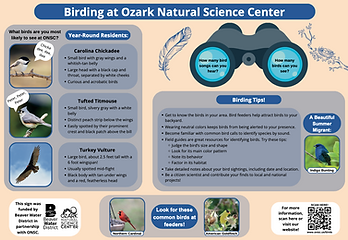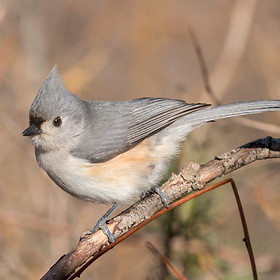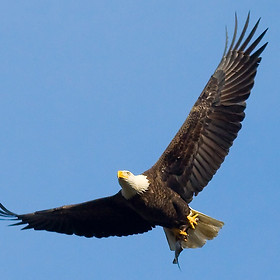Birding at ONSC and Beyond!
Birds are a lovely part of nature. Not only are they beautiful, but they are also fascinating to watch. Many naturalists enjoy birding, an activity where people go outside into nature to observe birds. Bird songs add another fun element to birding. Birds contribute greatly to the Ozark ecosystems, helping control insect populations, pollinate flowers, spread seeds for plant reproduction, and playing crucial roles in the food web as both predators and prey.
Tips for Identifying Birds:
-
Judge the bird’s size and overall shape.
-
Look for its main color patterns and any unique features.
-
Note its behavior, especially any repeated movements.
-
Listen for its song and/or other calls.
-
Factor in its habitat.
What Birds Are You Likely to See at ONSC?
At Bird Feeders:
Year-Round Residents
Carolina Chickadees (Poecile carolinensis) love sunflower seeds, but they’re also skilled insect hunters, often hanging upside down to search for bugs under bark or in spiderwebs. In the winter, you’ll find them in groups known as Feeding Flocks, which often include Tufted Titmice, woodpeckers, and visiting winter birds.
Interestingly, chickadees are the leaders of these flocks—wherever they go, the rest of the birds follow.Chickadees are curious by nature, and birders can attract them by making “pishing” noises (just say “Shhh” with a “p” in front of it). If a chickadee responds to your pishing, other birds in the flock might follow, giving you the chance to see some unusual species traveling with them. Their song is a cheerful “fee bee fee bay,” while their alarm call, “chicka dee dee dee,” gives them their name.
"Carolina Chickadee with Pastel Blue Bokeh Background #2 of 2 #Flickr12Days" by Cindy Sue Causey is licensed under CC BY-SA 2.0.

Non Year-Round Residents
Indigo Buntings (Passerina cyanea) are summer residents, coming to Arkansas to breed. They prefer cracked corn and other small seeds, which they forage from the ground or platform feeders. The striking bright blue males can often be seen singing from treetops during spring and summer, while the females are a more subdued brown with a whitish throat, faint streaking on the breast, and sometimes a hint of blue on their wings, tail, or rump.
The Indigo Bunting’s song is a distinctive double-note that moves down the scale, often sounding like “what! what! where? where? see it! see it!” or “Fire, fire, Here, here, Now, now.”
"Indigo bunting" by U.S. Fish and Wildlife Service - Midwest Region is marked with Public Domain Mark 1.0.

Birds Not at Feeders, but Still Easy to See:
Turkey Vultures (Cathartes aura) are year-round residents, nearly the size of eagles with a wingspan reaching almost 6 feet. They play a vital role in nature by scavenging and consuming dead animals, which helps prevent the spread of disease. Their featherless, red heads contrast with their dark brown bodies and serve a practical purpose—keeping them clean from the messy meals they consume.
Turkey Vultures are master soarers, using thermals (updrafts of warm air) to glide effortlessly, conserving energy. They are often seen floating high in the sky on sunny afternoons. One of the easiest ways to identify them is by their distinctive "V"-shaped wing posture when gliding.
Unlike many other birds, Turkey Vultures lack the vocal organs to produce proper songs. Instead, they can make a low, guttural hiss when irritated, or occasionally, a low, nasal whine during flight.
"Turkey vulture (Cathartes aura)" by Joshua Tree National Park is marked with Public Domain Mark 1.0.

Birds More Challenging to See (But Well Worth the Effort!):
Hooded Warblers (Setophaga citrina), Kentucky Warblers (Geothlypis formosa), Ovenbirds (Seiurus aurocapilla), Northern Parulas (Setophaga americana), Black-and-white Warblers (Mniotilta varia), and Pine Warblers (Setophaga pinus) all breed in the Ozarks during the summer.
These small, insect-eating birds can be elusive. The first three species often forage close to the ground in tangles of vegetation, while Northern Parulas spend most of their time higher in the trees. Black-and-white Warblers search for food on leaves and tree trunks, and Pine Warblers, as their name suggests, spend most of their time in pine trees.
Ruby-crowned Kinglets (Regulus calendula) and Golden-crowned Kinglets (R. satrapa) are tiny forest birds that visit the Ozarks in the winter. They are easily recognized by the frequent fluttering of their wings. Both species have tiny beaks and relatively plain plumage, except for white wing-bars. The Ruby-crowned Kinglet is distinguished by white eye-rings, and males show a brilliant red crown when excited. The Golden-crowned Kinglet, on the other hand, displays a bright yellow crown bordered in black.
Identifying Other Birds by Their Voices:
Sometimes, birds are heard but not seen, especially during the summertime when the deciduous trees are full and lush. Identifying birds by their voice is easier than you might think. Here are some common songs to help you recognize species in the area:
-
Ovenbirds are common in the ONSC woods during spring and summer, singing “Teacher! Teacher! Teacher!” with their voices growing louder as they go.
-
Black-and-white Warblers sound like a squeaky wheel, with a song that resembles “Weeesy, weeesy, weeesy.”
-
Eastern Phoebes (Sayornis phoebe) sing “Feebeee, feebeee” throughout the summer days.
-
Red-shouldered Hawks (Buteo lineatus), the most commonly heard hawks at ONSC, have a distinct two-tone call. Don’t be fooled by Blue Jays, which are excellent mimics of hawk calls.
-
American Crows (Corvus brachyrhynchos) are known for their familiar “Caw, caw, caw!”
-
Barred Owls (Strix varia) call out “Who cooks for you? Who cooks for you-all?” during the night, and sometimes even in the daytime.
-
Eastern Whip-poor-wills (Antrostomus vociferus) call their name throughout summer nights.
For more help identifying birds by their songs and calls, check out these resources:
-
Stanford University: Bird Songs
A collection of bird songs and calls, providing audio examples for identification. -
Smithsonian National Zoo: Bird Memory Phrases
Learn bird songs through easy-to-remember phrases that mimic the sound of common bird calls. -
USDA Forest Service: Bird Sound Identification Guide
A detailed guide to bird sound identification, with examples of bird species commonly found in U.S. forests.
Other Helpful Birding Links:
Northwest Arkansas Audubon Society https://www.nwarkaudubon.org/ : Field Trips occur regularly throughout the year. They are free and open to the public; children over the age of 5 are welcome. See the schedule on the website. Also on the website are Places to Bird in Northwest Arkansas; a link to the Wildlife Rescue Directory; Books for Birders; current issues and other useful topics. Visit the site to learn more.
Arkansas Audubon Society https://arbirds.org/ : A non-profit, 100% volunteer-operated organization for the study, conservation and enjoyment of birds. They run the Halberg Ecology Camp, a summer outdoor nature camp for 5th and 6th graders. There is also a Bird-Friendly Arkansas Certification Program and a Birds of Arkansas database. You can learn about upcoming meetings and conventions. You can also sign up for ARBIRD, a birds of Arkansas discussion list, to receive and send emails about birds. Birders often post their recent exciting bird discoveries.
The Cornell Lab of Ornithology https://www.birds.cornell.edu/home
The Cornell Lab of Ornithology’s mission is “to interpret and conserve the earth’s biological diversity through research, education, and citizen science focused on birds and nature.” They have many amazing resources and opportunities to learn about and help birds. Here are a few:
-
All About Birds https://www.allaboutbirds.org/guide/
(an online guide to birds and birdwatching)
-
eBird https://ebird.org/home (A Citizen Science project, operated by The Cornell Lab of Ornithology) On this site you can enter your own data, or explore data that has been collected over several years by birders throughout the world. There is also a link to Merlin, a free global bird id and field guide app that will help you to identify birds by their calls–see extra link below. All sorts of cool information can be found on this site!
-
Project Feeder Watch https://feederwatch.org/ (a November-April survey of birds that visit backyards, nature centers, community areas, and other locales in North America)
-
Merlin Bird ID https://merlin.allaboutbirds.org (Free bird identification app)
If you find injured or sick birds, check these links:
Morning Star Wildlife Rehabilitation Center (also cares for other animals) https://www.nwarkaudubon.org/morning-star.html
Northsong Wild Bird Rehabilitation: https://www.northsongbird.org/ A center for the rehabilitation of injured or orphaned wild birds, with the goal of release back to the wild if possible.














